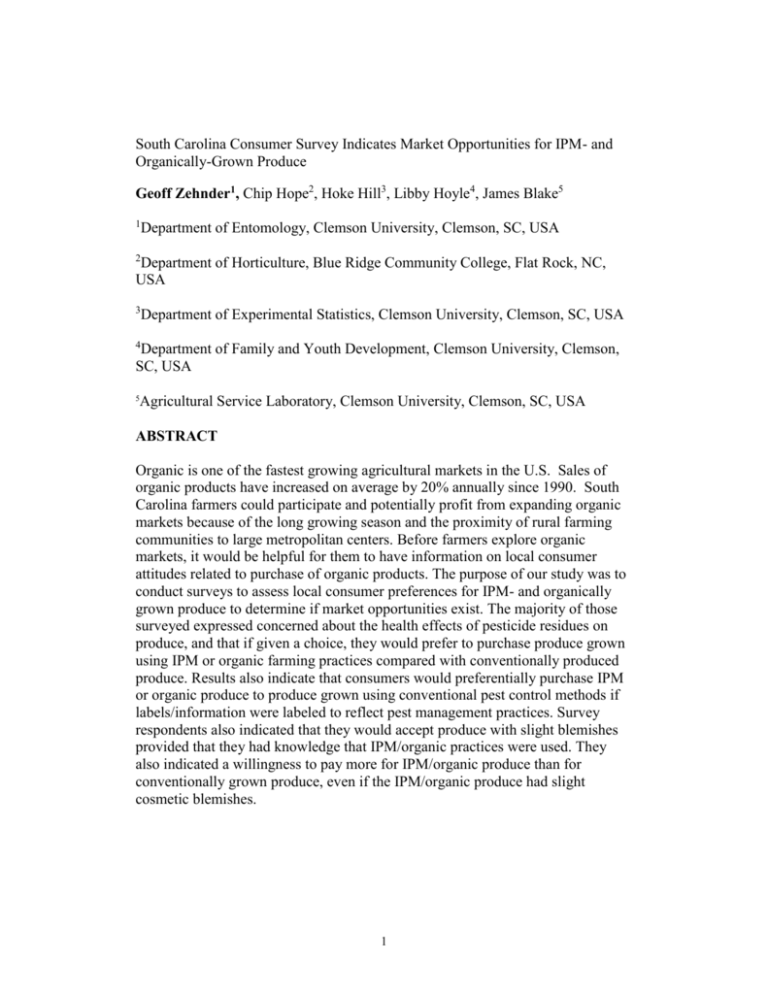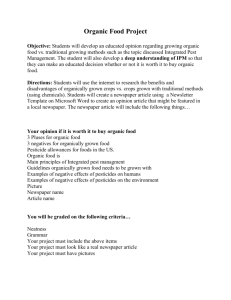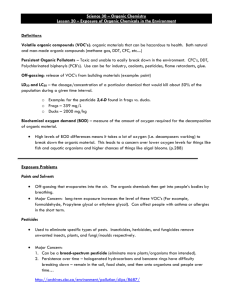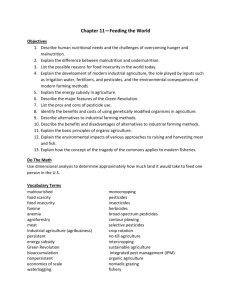Introduction - UF/IFAS Office of Conferences and Institutes
advertisement

South Carolina Consumer Survey Indicates Market Opportunities for IPM- and Organically-Grown Produce Geoff Zehnder1, Chip Hope2, Hoke Hill3, Libby Hoyle4, James Blake5 1 Department of Entomology, Clemson University, Clemson, SC, USA 2 Department of Horticulture, Blue Ridge Community College, Flat Rock, NC, USA 3 Department of Experimental Statistics, Clemson University, Clemson, SC, USA 4 Department of Family and Youth Development, Clemson University, Clemson, SC, USA 5 Agricultural Service Laboratory, Clemson University, Clemson, SC, USA ABSTRACT Organic is one of the fastest growing agricultural markets in the U.S. Sales of organic products have increased on average by 20% annually since 1990. South Carolina farmers could participate and potentially profit from expanding organic markets because of the long growing season and the proximity of rural farming communities to large metropolitan centers. Before farmers explore organic markets, it would be helpful for them to have information on local consumer attitudes related to purchase of organic products. The purpose of our study was to conduct surveys to assess local consumer preferences for IPM- and organically grown produce to determine if market opportunities exist. The majority of those surveyed expressed concerned about the health effects of pesticide residues on produce, and that if given a choice, they would prefer to purchase produce grown using IPM or organic farming practices compared with conventionally produced produce. Results also indicate that consumers would preferentially purchase IPM or organic produce to produce grown using conventional pest control methods if labels/information were labeled to reflect pest management practices. Survey respondents also indicated that they would accept produce with slight blemishes provided that they had knowledge that IPM/organic practices were used. They also indicated a willingness to pay more for IPM/organic produce than for conventionally grown produce, even if the IPM/organic produce had slight cosmetic blemishes. 1 INTRODUCTION South Carolina is experiencing unprecedented rates in growth of acreage converted from farmland into developed land status. From 1992 to 1997, 30.2% of South Carolina farm and forestland was converted for development (London and Hill 2000). This ranks South Carolina 6th in the nation among states in this category, and the rate of development and loss of farmland is expected to continue. Concurrent with development has been an increase in land values and property tax rates making it more difficult for farmers to maintain profitable enterprises. Farmers on small acreage farms typical of South Carolina (average size approximately 200 acres) can no longer survive economically solely by growing and marketing conventional, low-value row crops. Thus, farmers are interested in alternative niche market crops where the per-acre profit potential is high. Organic is one of the fastest growing agricultural markets in the U.S. Despite the lack of national organic standards before this year, certified organic cropland more than doubled between 1992 and 1997 (Greene 2001). Sales of organic products have increased on average by 20% annually since 1990 (Greene 2001). Implementation in 2002 of national standards for organically produced commodities (under the USDA National Organic Program) will facilitate marketing of organic products in the U.S. and abroad. Medium term growth forecasts for U.S. organic markets is in the range of 20-30% (Anonymous 1999). Publication of the National Academy of Sciences study on pesticides in the diets of infants and children (National Academy of Sciences 1993) focused public attention on health effects relating to pesticide residues on fresh and processed fruits and vegetables. A survey of supermarket customers in Oklahoma and Texas indicated that over 70% of consumers were concerned about the health effects of pesticide residues and were willing to pay over 10% price premium for pesticide residue-free produce (Collins et al. 1992). South Carolina farmers could participate and potentially profit from expanding organic markets because of the long growing season and the proximity of rural farming communities to large metropolitan centers like Charleston, Columbia and Greenville. Before farmers explore organic markets, it would be helpful for them to have information on local consumer attitudes related to purchase of organic products. The purpose of our study was to assess local consumer preferences for IPM- and organically grown produce to determine if market opportunities exist. Questions relating to IPMgrown produce were included because IPM has been used as a focal point for 2 marketing programs (New York State IPM Program 1999), and to determine if consumer attitudes towards IPM- and organically grown produce differed. Survey Procedures A Consumer Buying Preferences Survey was developed to assess local consumer attitudes related to purchase of IPM/organic produce (Table 1). The following questions were included in the survey: Are you concerned about health effects related to pesticide residues on fresh produce? (1 = not concerned, 2 = slightly concerned, 3 = moderately concerned, 4 = extremely concerned). If information on the type of pesticide applied and the number of pesticide applications to produce were provided at the point of sale, would you take this into consideration when selecting produce for purchase? Which would you be most likely to purchase? (rank in order of preference): Produce grown using IPM methods Produce grown using organic methods Produce grown using conventional pest control methods Which would you be most likely to purchase?: Perfect-looking produce produced by a farmer using regularly scheduled pesticide applications Produce with some slight, cosmetic blemishes produced using little or no pesticides Would you be willing to pay more for produce grown using little or no pesticides if this produce had no blemishes? If yes, how much more? (choices ranged from <5% to >25%) Would you be willing to pay more for produce grown using little or no pesticides if this produce had some slight, cosmetic blemishes? If yes, how much more? (choices ranged from <5% to >25%) Respondents were also asked to provide demographic information on age, education and income level. A brief introduction on the first page of the survey provided general definitions for integrated pest management (IPM) and organic crop production. 3 The surveys were distributed to visitors at three Plant and Flower Festivals organized by the South Carolina Department of Agriculture in Charleston, Florence and Greenville. Charleston and Greenville are predominantly urban counties (337 and 480 residents per square mile, respectively) and Florence is a more rural county (157 residents per square mile; year 2000 U.S. Census Bureau figures). The festivals attract visitors interested in home landscaping and gardening; therefore survey respondents may have had some experience with pesticides. Surveys were given to100 people at each location; respondents were given free heirloom tomato transplants for completing the survey. Data Analysis Of the 300 surveys distributed, 250 provided usable data that were included in the analysis. Response data were initially sorted by location and subjected to analysis of variance (ANOVA) to determine if responses differed by location. No significant differences (P > 0.05) in mean response values among locations were identified for any of the questions. ANOVA were also performed on data sorted by demographic factors (age, education, income) to determine if these factors influenced response trends. Only one of 24 analyses identified significant differences (see Results), so data from all locations and demographic categories were pooled and frequency tables developed for each question. RESULTS The majority of respondents (56.6%) ranged in age from 36 to 55 years and 30.5% were older than 56 years (Table 1). Over half were college graduates and 24.4% indicated that they had obtained a graduate or professional degree. Household income for over half of the respondents was greater than $40,000. ANOVA did not identify significant differences (P < 0.05) in response values among the three locations. The only significant difference in response values among the various demographic categories occurred with Question #3 (see discussion below). Table 1. Percentage of Respondents in Age, Education and Income Categories (N=250) Age % 18-25 0.7 26-35 12.1 36-45 25.7 4 46-55 30.9 56-65 17.3 > 65 13.2 Education % < 12 grade 3.3 HS Grad 16.0 College 29.1 Col. Grad Grad Deg. 27.3 24.4 Income % <$15,000 3.9 $15-25K 13.1 $25-40K 25.1 $40-55K 22.8 $55-75K 15.1 > $75K 20.1 To the first question relating to perceptions about the health effects of pesticide residues, 53.6% of respondents expressed extreme concern and 35.1% indicated moderate concern about negative health effects from pesticide residues on produce. Only 1.8% were not concerned about health effects of pesticide residues. Over 95% of respondents indicated that they would consider pesticide use information (e.g., type of pesticide applied, number of applications) when purchasing produce if this information were available at the point of sale (question #2). When asked to indicate their preference for produce grown using IPM, organic, or conventional pest control methods (question #3), 35.8% and 42.3% of respondents indicated that they would most prefer IPM- and organically grown produce, respectively. ANOVA identified significant differences among education categories in responses to the question about preferences for organic produce. Here, people were asked to rank preference for organic produce (1 = most prefer, 2 = moderately prefer, 3 = least prefer). Respondents in the highest education category had an average response value of 1.95, and response values in the other education categories averaged 1.65 (values were significantly different; F = 3.99, P = 0.004). This suggests that respondents in the highest education category demonstrated less preference for organic produce. However, only 6.4% of those surveyed indicated that they would most prefer conventionally grown produce (e.g., pesticides applied on a routine or scheduled basis). Question #4 addressed consumer-buying preferences based on the cosmetic appearance of produce and pesticide use. A large majority of respondents (84.2%) indicated that they would be most likely to purchase produce with some slight blemishes if grown using little or no pesticides. Only 15.8% indicated that they preferred perfect-looking produce that received regular pesticide applications. Most respondents (90.9%) to question #5 indicated that they would be willing to pay more for IPM- or organically grown produce with no blemishes. Interestingly, almost the same percentage (88.6%) indicated that they would pay more for IPM/organic produce with some slight cosmetic blemishes. Half of the respondents indicated that they would pay 5-10% more for produce grown using little or no pesticides if the produce had no blemishes, and almost the same percentage (46.4%) indicated that they would pay the same premium for IPM/organic produce with some slight cosmetic blemishes. Approximately 20% 5 indicated that they would pay a 10-15% price premium, and 6 to 7.8% a 15-20% premium, for IPM/organic produce with or without blemishes. A smaller percentage indicated that they would even pay more than 25% over normal cost for IPM/organic produce with (3.8%) or without (4.9%) blemishes. DISCUSSION These results indicate that local market opportunities exist for IPM/organic produce, and that consumer preferences for IPM and organic produce were similar. Results from Question #1 suggest that the majority of consumers are concerned about the health effects of pesticide residues on produce, and that if given a choice, they would prefer to purchase produce grown using IPM or organic farming practices compared with conventionally produced produce. Compared with national averages from U.S. Census Bureau statistics (U.S. Census Bureau 2000), our survey population had a higher percentage of college graduates (51.7% vs. 26%). Thus, it may be argued that the overwhelming preference for IPM/organic produce may be related to a higher level of education. However, ANOVA indicating no significant differences in response values among education or income categories suggests that these factors do not influence attitudes towards purchase of IPM/organic produce among our survey population. Most of those surveyed responded that they would consider pesticide use information at the point of sale in their decision to purchase produce. This suggests that information on pest management practices provided at the market place could be used to provide a marketing advantage for IPM/organic produce. Results also indicate that consumers would preferentially purchase IPM or organic produce to produce grown using conventional pest control methods if labels/information were labeled to reflect pest management practices. The percentage of respondents who would most prefer to buy organic produce was only 7% greater than the percentage that most preferred IPM produce. This suggests that the market for IPM produce may be as strong as for organic produce if consumers were provided information on IPM and could identify IPM produce at the point of sale. A large majority of respondents (84.2%) indicated a willingness to purchase produce with slight cosmetic blemishes if they had knowledge that the product was produced with little or no pesticides. One of the main constraints to production and marketing of IPM/organic produce is the difficulty in maintaining high standards for appearance with limited or zero use of pesticides. Survey results indicated that consumers would accept produce with slight blemishes 6 provided that they had knowledge that IPM/organic practices were used. Survey results also indicate that consumers would be willing to pay more for IPM/organic produce than for conventionally grown produce, even if the IPM/organic produce had slight cosmetic blemishes. Based on survey responses, an acceptable price premium would be in the 5-15% range, although a small percentage would pay 25% more for IPM/organic produce. REFERENCES Anonymous (1999). Organic food and beverages: World supply and major European markets. International Trade Center, Geneva, 271 pp. Collins, J.K., Cuperus, G.W., Cartwright, B., Stark, J.A. & Ebro, LL. 1992. Consumer attitudes on pesticide treatment histories of fresh produce. Journal of Sustainable Agriculture 3: 81-98. Greene, C.R. (2001). U.S. organic farming emerges in the 1990s: Adoption of certified systems. USDA-ERS, Agriculture Information Bulletin No. 770. Available at: http://www.ers.usda.gov/publications/aib770/ New York State IPM Program (1999). IPM labeling effort: The growing market for IPM labels. Available at: http://www.nysipm.cornell.edu/labeling/label2.html. London, J. B. & Hill, N.L. (2000). Land conversion in South Carolina: State makes the top 10 list. Jim Self Center on the Future, Strom Thurmond Institute, Clemson University. Available at: http://www.strom.clemson.edu/primelands/. National Academy of Sciences (1993). Pesticides in the diets of infants and children. National Academy Press, Washington, DC. 1993. U.S. Census Bureau (2000). Educational attainment in the United States (update; March 2000), publication #P-20-S36. Available at: http://www.census.gov/population/www/socdemo/educ-attn.html Corresponding Author: Geoff Zehnder, Clemson University Address: Dept. of Entomology, 114 Long Hall, Clemson University, Clemson, SC 29634, Phone: 864/656-6644; Fax: 656-6863, Zehnder@clemson.edu Paper submitted for poster presentation; Theme: Small Farm Diversification and Competitiveness 7







